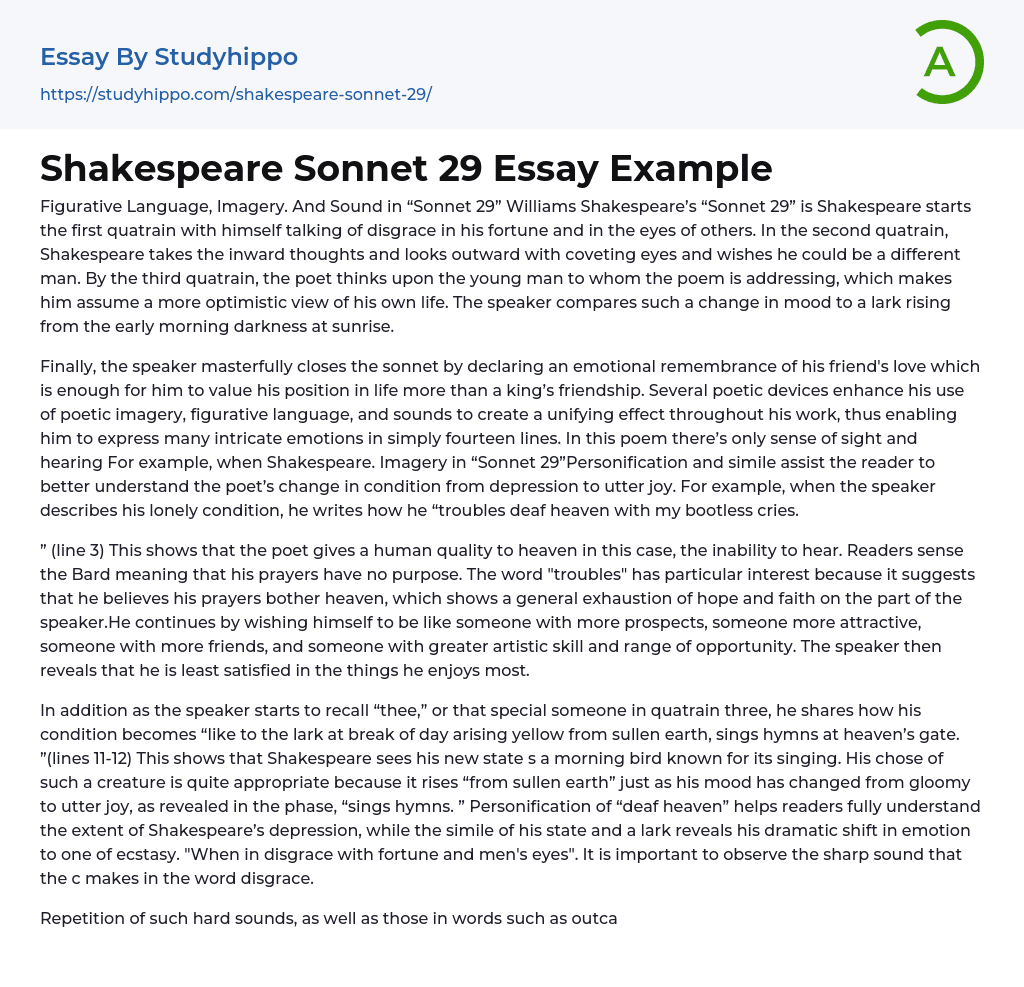Figurative Language, Imagery. And Sound in “Sonnet 29” Williams Shakespeare’s “Sonnet 29” is Shakespeare starts the first quatrain with himself talking of disgrace in his fortune and in the eyes of others. In the second quatrain, Shakespeare takes the inward thoughts and looks outward with coveting eyes and wishes he could be a different man. By the third quatrain, the poet thinks upon the young man to whom the poem is addressing, which makes him assume a more optimistic view of his own life. The speaker compares such a change in mood to a lark rising from the early morning darkness at sunrise.
Finally, the speaker masterfully closes the sonnet by declaring an emotional remembrance of his friend's love which is enough for him to value his position in life more than a king’s friendship. Several poetic devices enhance his use
...of poetic imagery, figurative language, and sounds to create a unifying effect throughout his work, thus enabling him to express many intricate emotions in simply fourteen lines. In this poem there’s only sense of sight and hearing For example, when Shakespeare. Imagery in “Sonnet 29”Personification and simile assist the reader to better understand the poet’s change in condition from depression to utter joy. For example, when the speaker describes his lonely condition, he writes how he “troubles deaf heaven with my bootless cries.
” (line 3) This shows that the poet gives a human quality to heaven in this case, the inability to hear. Readers sense the Bard meaning that his prayers have no purpose. The word "troubles" has particular interest because it suggests that he believes his prayers bother heaven, which shows a general
exhaustion of hope and faith on the part of the speaker.He continues by wishing himself to be like someone with more prospects, someone more attractive, someone with more friends, and someone with greater artistic skill and range of opportunity. The speaker then reveals that he is least satisfied in the things he enjoys most.
In addition as the speaker starts to recall “thee,” or that special someone in quatrain three, he shares how his condition becomes “like to the lark at break of day arising yellow from sullen earth, sings hymns at heaven’s gate. ”(lines 11-12) This shows that Shakespeare sees his new state s a morning bird known for its singing. His chose of such a creature is quite appropriate because it rises “from sullen earth” just as his mood has changed from gloomy to utter joy, as revealed in the phase, “sings hymns. ” Personification of “deaf heaven” helps readers fully understand the extent of Shakespeare’s depression, while the simile of his state and a lark reveals his dramatic shift in emotion to one of ecstasy. "When in disgrace with fortune and men's eyes". It is important to observe the sharp sound that the c makes in the word disgrace.
Repetition of such hard sounds, as well as those in words such as outcast, curse, and cries serves to quicken the tone of the sonnet, and give it a sense of anxiousness. Imagery, figurative language and mood support Shakespeare’s view of magery early in the sonnet and introducing it so vibrant;y wonderful his love truly is. The reader will view how the speaker evisions in his words. Lastly, the personification of “deaf heaven” leads
the reader to better understand how lonely he is when no one was there to hear his cries. Though the reader knows that heaven does not really have ears, the poet is showing his cries of hopelessness.
- Book Summary essays
- Metaphor essays
- Reader essays
- Rhyme essays
- Literary devices essays
- Villain essays
- Books essays
- Genre essays
- Literary Criticism essays
- Writer essays
- Protagonist essays
- Simile essays
- Poem essays
- Book Report essays
- Book Review essays
- Greek Mythology essays
- Plot essays
- Tragic Hero essays
- Coming of Age essays
- Play essays
- Rhetoric essays
- Rhetorical Question essays
- Translation essays
- Understanding essays
- Reason essays
- Character essays
- Letter essays
- American Literature essays
- Literature Review essays
- Utopia essays
- Poetry Analysis essays
- Dante's Inferno essays
- Between The World and Me essays
- Incidents in The Life of a Slave Girl essays
- Flowers for Algernon essays
- Myth essays
- Everyday Use essays
- Boo Radley essays
- Genesis essays
- Richard iii essays
- Alice in Wonderland essays
- On the road essays
- Ozymandias essays
- The Nightingale essays
- Holden Caulfield essays
- Animal Farm essays
- 1984 essays
- A Hanging essays
- Shooting An Elephant essays
- A Tale Of Two Cities essays




